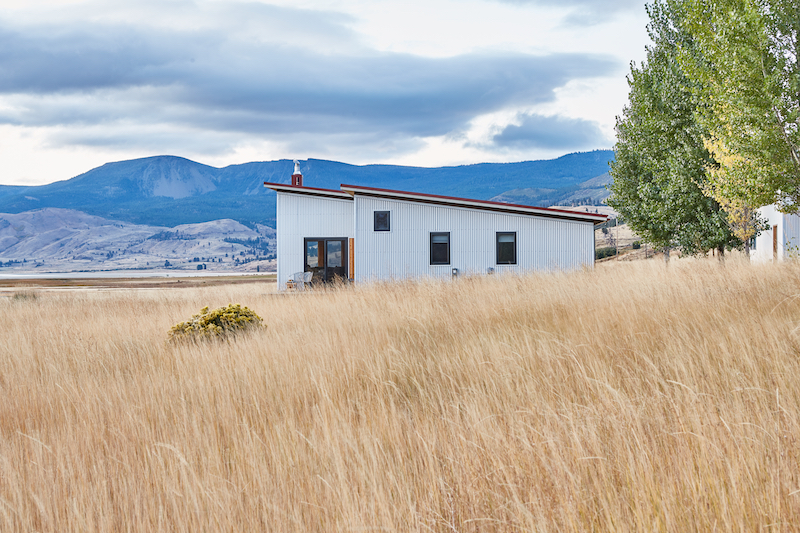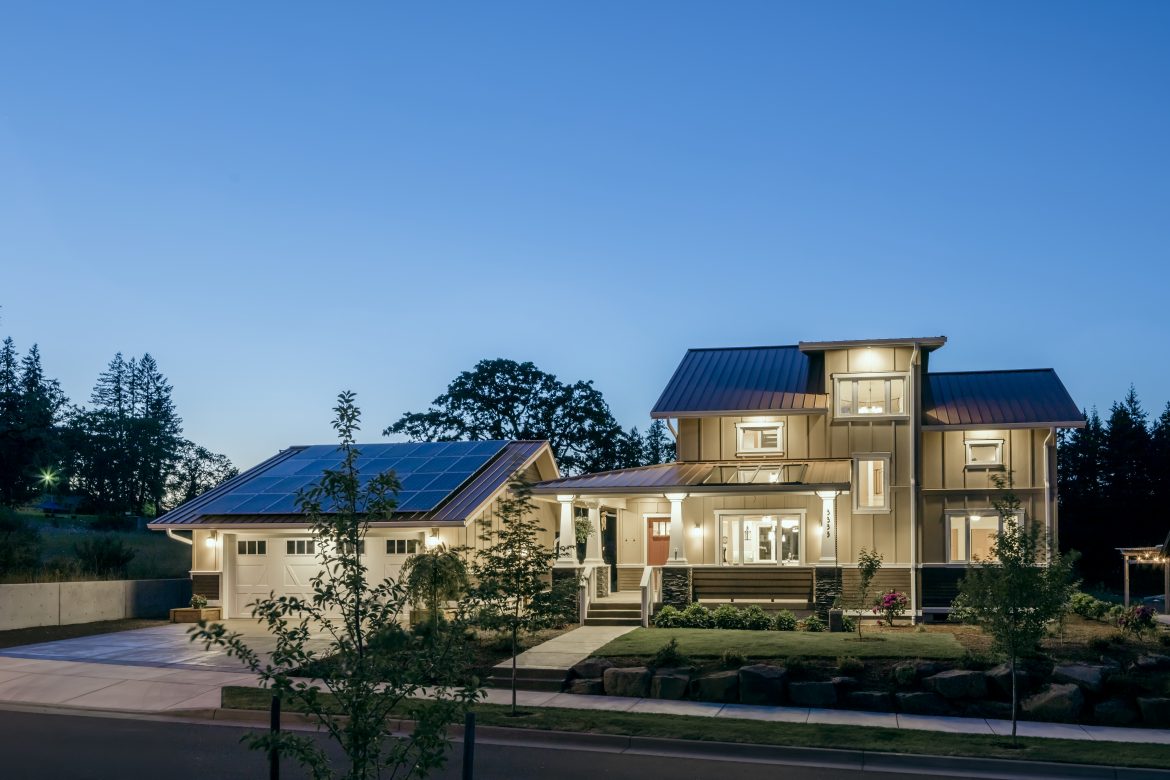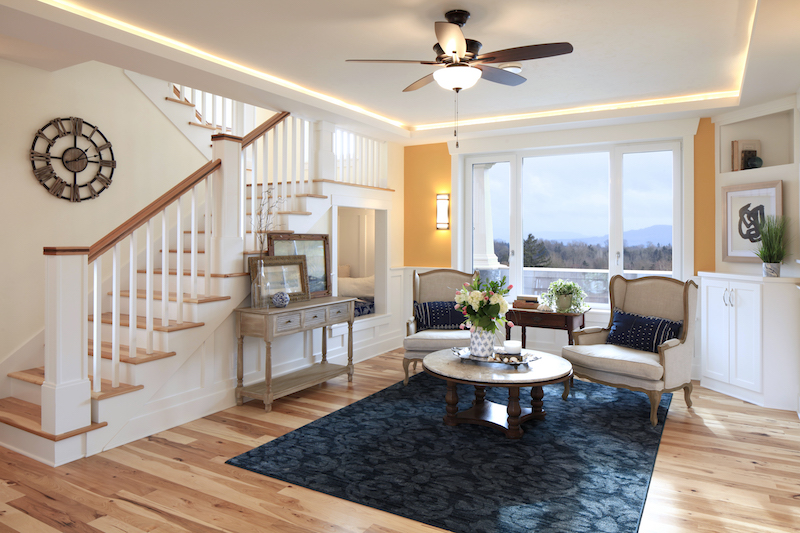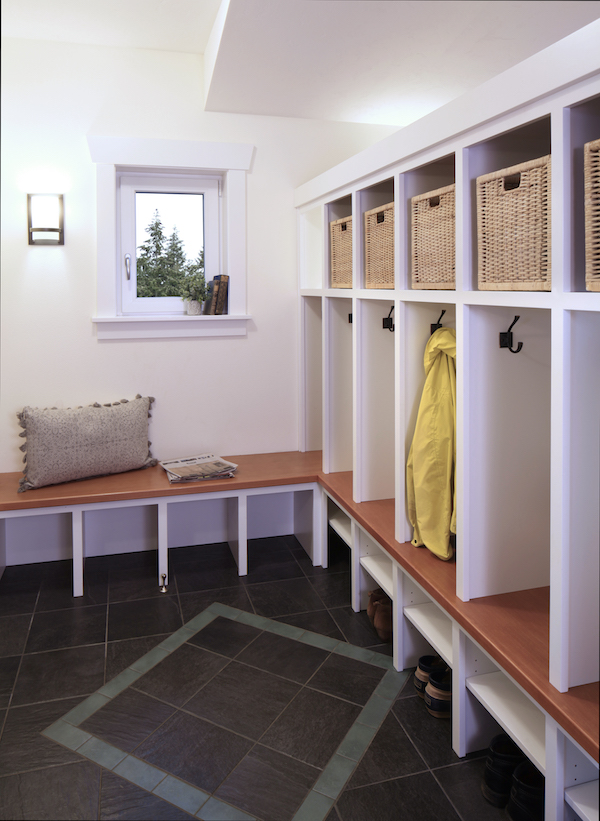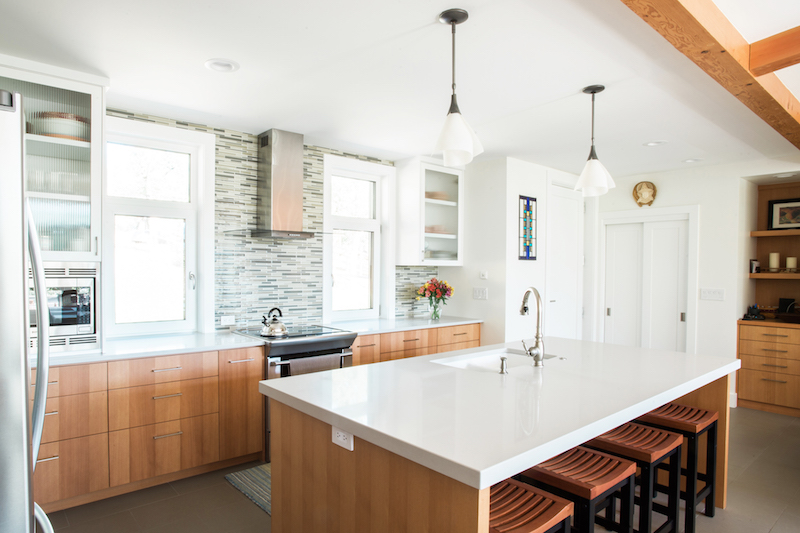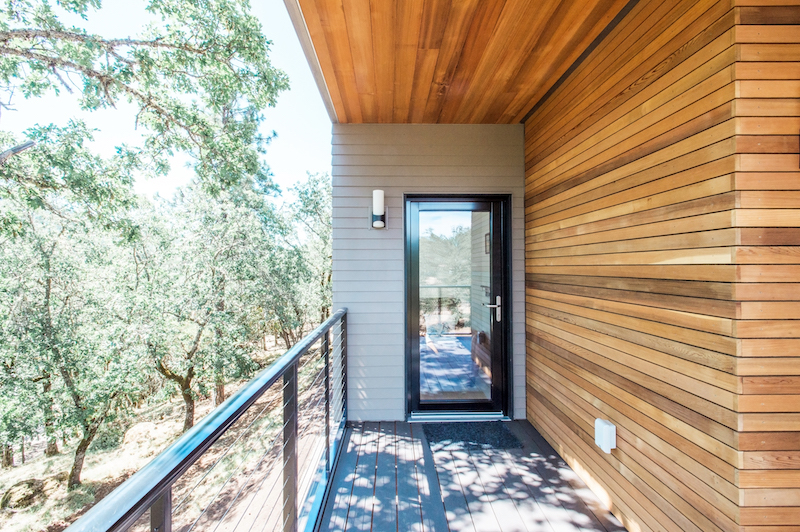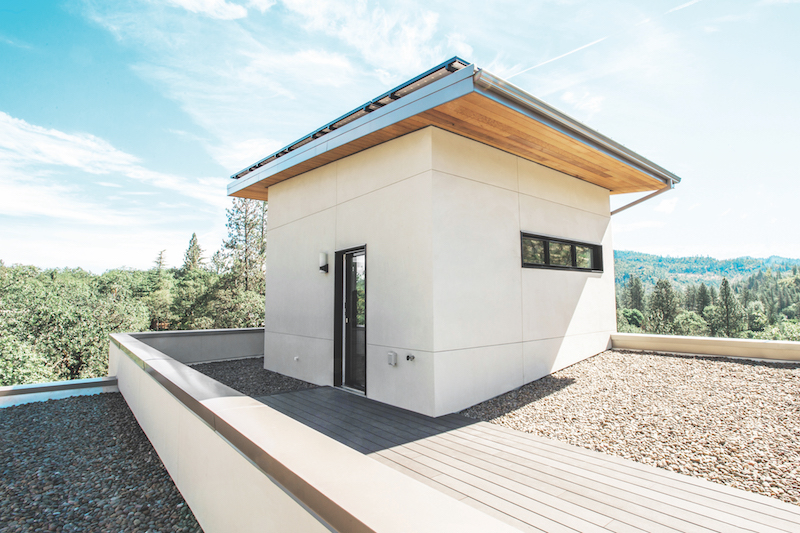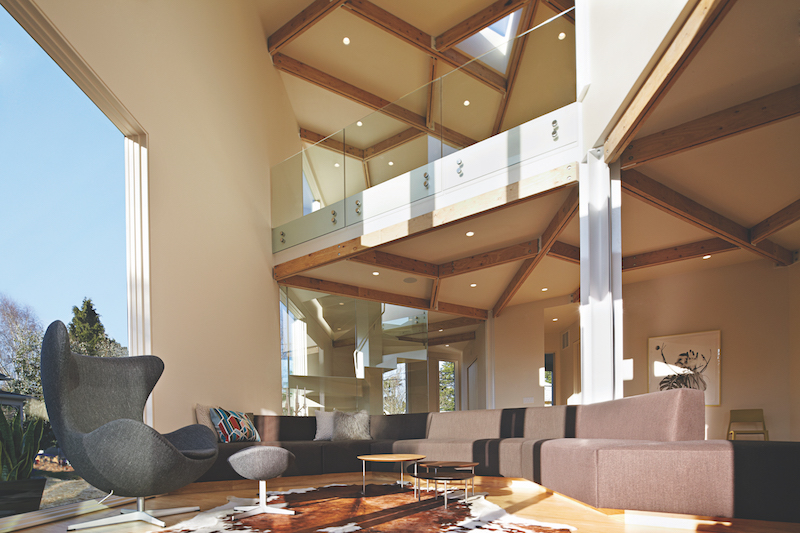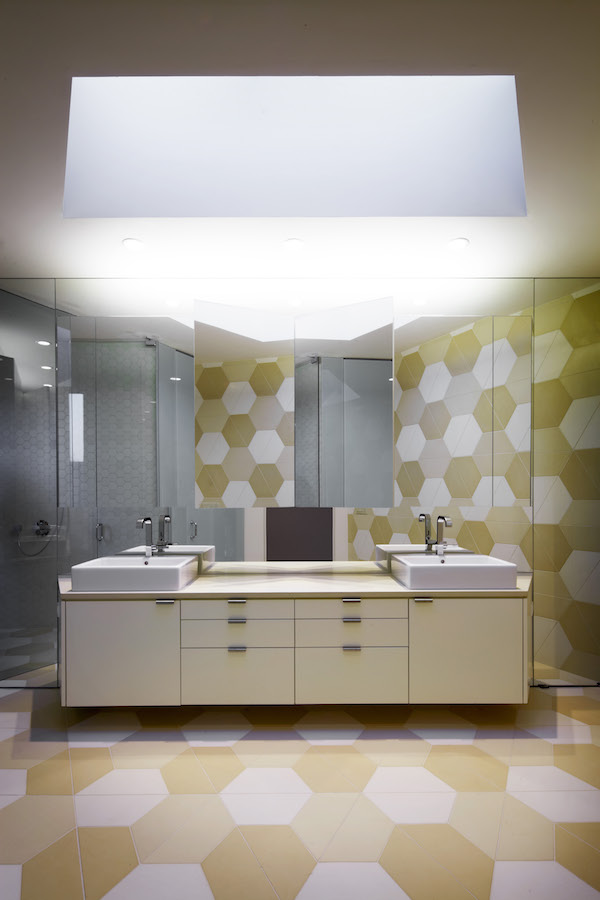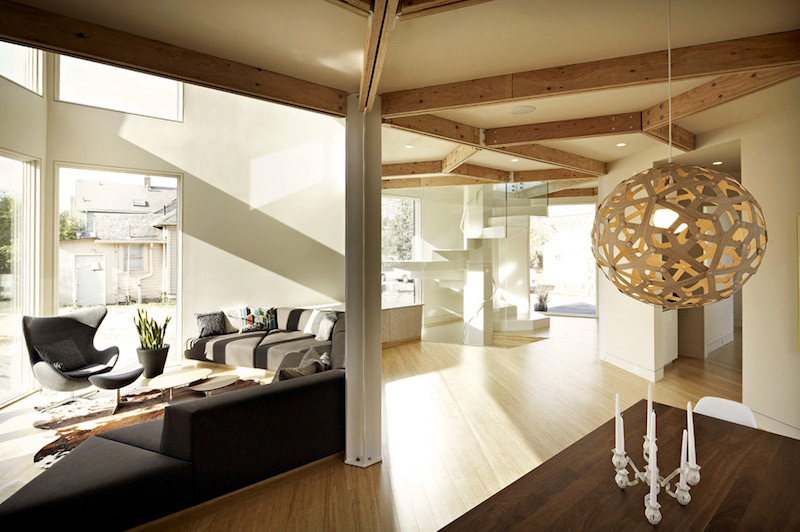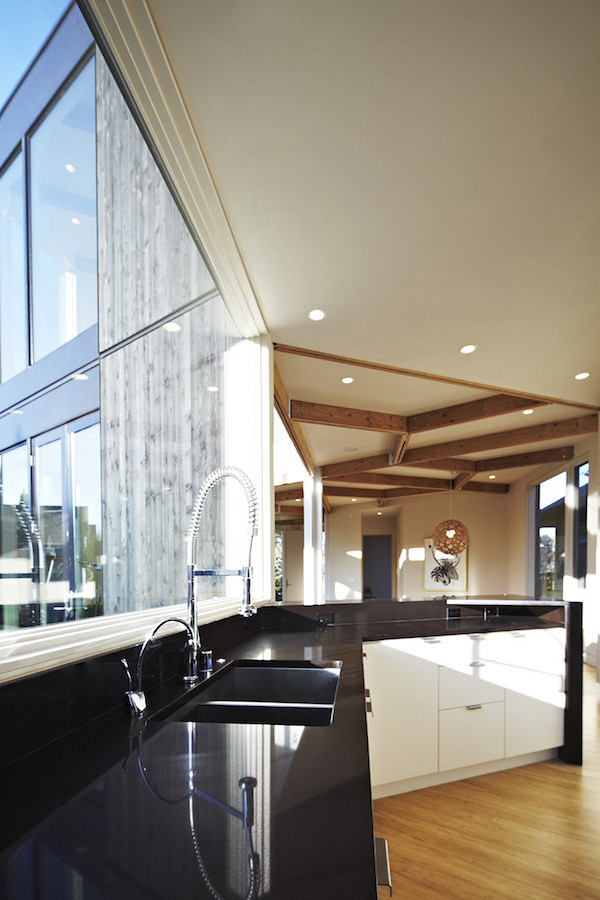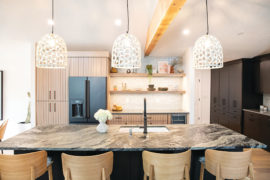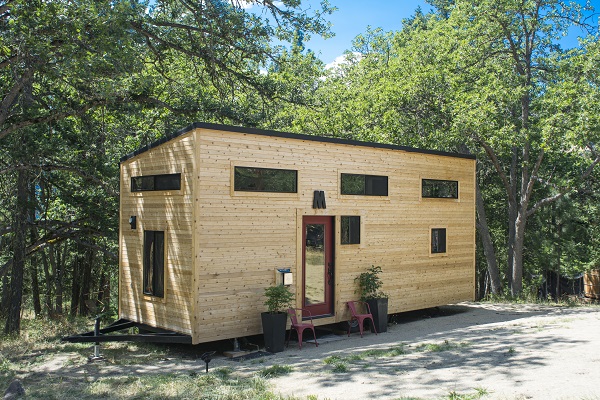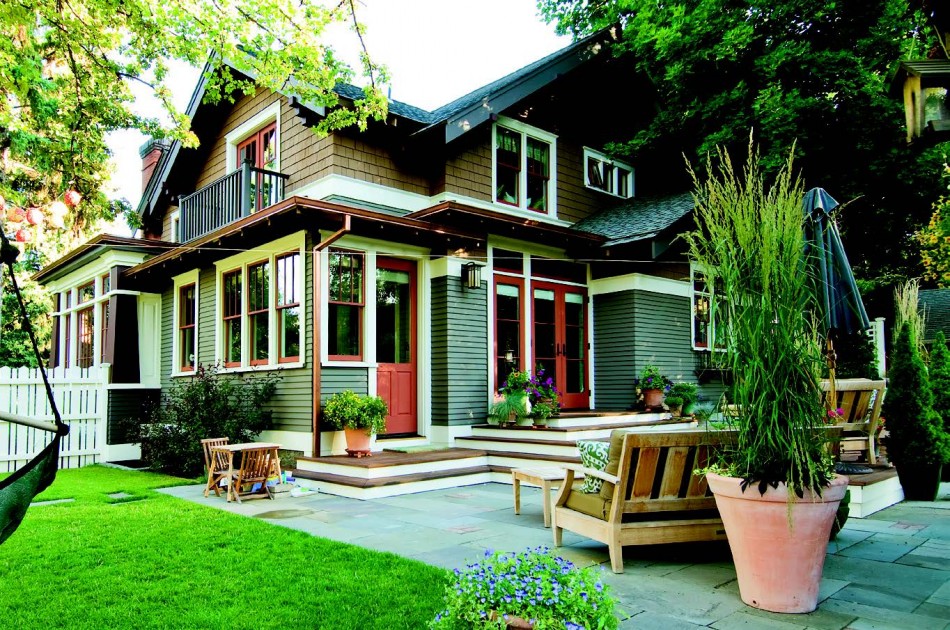Step inside these recent sustainable home designs around the state
written by Melissa Dalton
Oregon has some serious green building cred, but there’s always room for improvement. Governor Kate Brown led the state into an embrace of energy conservation when, last November, she signed an executive order stating that newly constructed residences must demonstrate 40 to 50 percent more energy efficiency than conventional construction. Intrigued, we checked out three recent sustainable builds to better understand what our future neighborhoods might look like.
The First Passive House in Corvallis
exterior photography by David Paul Bayles | interior photography by Jen G. Pywell
Choosing to Build their first home was a no-brainer for Carl and Julie Christianson. He runs G. Christianson Construction, which was started by his parents in Corvallis in 1986. Less obvious is that the couple would make their home a certified Passive House. Although Carl’s company had never built one, the project suited his natural curiosity. “As someone who’s into gadgets and being innovative, this is an innovative way to build,” Julie Christianson said. “It’s a release for his creativity, trying to figure out how to make it all work.” Buildings, both residential and commercial, account for 39 percent of energy use across the United States, with most of that energy obtained from fossil fuels and nuclear sources. Constructing to the Passive House standard is a tried-and-true method to drastically reduce a home’s energy consumption and thereby the carbon emissions that result from the energy generated for the structure.
The Passive House model attains such energy efficiency through a concert of components, including continuous insulation and elimination of thermal bridges for airtightness, high-performance windows and doors, and controlled ventilation. Gaining experience with Passive House construction, and becoming certified in the approach, was a logical step for Christianson as more customers seek to save energy. “As a builder in town, that’s definitely the direction we wanted to go as a company,” Christianson said. Once the Christiansons found an empty lot in the Brooklane neighborhood, they collaborated with Eugene architect Jan Fillinger, a self-described “passive house geek” and co-author of a book on the subject. Fillinger and a team of consultants delivered the complex modeling needed for Christianson’s crew to achieve such high levels of airtightness, while the couple pored over the home’s details. The Christiansons knew they wanted a Craftsman-style home from the beginning. “I think a lot of people think a Passive House has to look modern,” Julie Christianson said. Now, quality finishes and a thoughtful use of space govern the home, from the gracious front porch to the classic interior trim and generous windows.
The house brims with personal touches, such as the hickory floor inlaid with a compass rose that recalls Julie Christianson’s summers on a tall ship, and the “reading cave,” an alcove under the stairs that reminds Carl Christianson of a childhood spent reading books beside his father’s rocking chair. Then there’s the intangible benefits, like a stable internal air temperature from all the insulation, no pesky drafts, and continuously filtered air free of pollens and pollutants. “I think a lot of people look strictly at the cost of the components,” Christianson said. “But what they’re missing is that by putting all the pieces together, you end up with a house that’s really comfortable.” In 2017, the project became the first certified Passive House in Corvallis, and with solar panels installed on the garage, is nearly Net Zero. Yet as important as such details are, the bigger picture is even more so. “Carl’s house avoids 19 tons of CO2 every year compared to a code house,” Fillinger said. “If all houses throughout the entire United States did that, it is possible to slow down carbon emissions to the point that we can slow down global warming and eventually, hopefully, reverse it.”
A Net Zero Home for Retirement in Shady Cove
photography by Claire Thorington
In order to prepare a realistic budget for retirement, you have to trim the fat. While concocting their plans, David and Debbie Hill figured out one way to keep their monthly household costs down—the couple built their forever home to Net Zero energy standards. Why? “So our utility bills won’t be very high!” Debbie Hill said. “We’re retirees. It just seemed like the way to go.” Prior to moving to Southern Oregon, the Hills lived in Columbus, Ohio, for thirty years and worked as information analysts for a division of the American Chemical Society. Upon inheriting a 1-acre lot in the small town of Shady Cove, they decided to swap out the dilapidated house on it for one that would suit their lifestyle. “We wanted to build a smaller, energy-efficient home for retirement,” Debbie Hill said. “I didn’t want a big house to clean. A smaller house would be convenient for us to grow old in.” The couple worked with architect Erica Dunn from the design/build firm Green Hammer to create a 3,200-square-foot home that balances peak energy efficiency with warm and modern conviviality. Dunn started by designing the home to Passive House principles. “With our focus on the Passive House envelope, it’s the most cost-effective way to get to Net Zero energy and drive those loads down,” she said.
Triple-pane windows, superior insulation and careful positioning on the lot to optimize solar exposure are all supplemented by a rooftop solar array to achieve Net Zero. That means the house generates as much renewable energy over the course of the year as it consumes. “In the summer, our [monthly] electric bills, even though we run the AC, are just a minimal $10.96,” Hill said. The house is tied to the grid, so that amount covers a standard connection fee imposed by the power company. Next, Dunn incorporated aging-in-place strategies to ensure the home would comfortably accommodate all of the occupants, which include the Hills, Debbie’s father and their four dogs. The lot slopes down at the back toward the Rogue River, so Dunn kept the house at a low profile on the approach, with all of the primary living spaces on-grade with the site. “ The thought was that a wheelchair wouldn’t have any thresholds to cross on the main floor,” Dunn said. A plethora of built-in storage and durable finishes make for easy maintenance, as well as an organic, modern aesthetic. “We used a lot of fir throughout, because that has such a nice rich color and tone to it,” Dunn said. at warmth extends to the exterior, where multiple inset porches are clad with cedar reclaimed from a deconstructed wood trestle bridge in the region. These days, the Hills are living just the life they sought in their new house, whether that’s listening to the sound of the river from the porch or enjoying the night sky from the rooftop deck. “It’s certainly built to meet all our needs,” David Hill said. “ That is, everything we need and nothing we don’t.”
Small, Smart & Sustainable
Salem / Eco-rated Prefab Homes
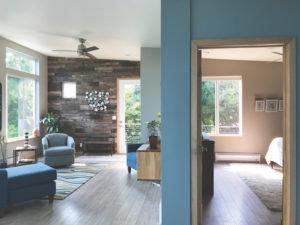
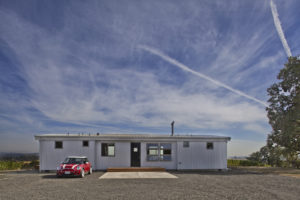
photos courtesy of ideabox
In the early aughts, architect Jim Russell saw a niche in the market. “We were watching the initial versions of what prefab is today,” Russell said. “We were looking at what was in the magazines and seeing that they were all at a pretty high price point.” Russell, who has a career background in energy and resource efficiency and factory-built housing, decided to take a different approach and in 2006, launched ideabox, which creates small, well-designed, affordable, green-rated prefab homes. Based in Salem, ideabox now has a range of models and sizes to choose from, starting from the 430-square-foot minibox for $111,800 and climbing to the 1,658-square-foot Roadrunner for $198,900. Each home comes equipped with a menu of green features, including a well-insulated shell, energy efficient windows, Energy Star appliances, no-VOC paints and low-to no-formaldehyde cabinetry. But most important to Russell is that customers get a home that suits the way they like to live. “One of the compliments that we get from clients is that they know they’re in a house that’s unique,” Russell said. “And for us, any time we can build something that’s smaller and lessens the carbon footprint, that’s a pretty rockin’ place to live.”
Summer Lake / A Small Rural Retreat
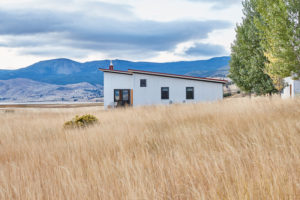
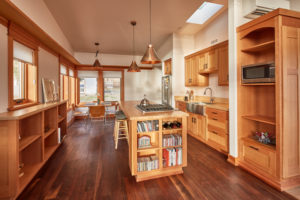
photography by Bronson Studios Photography
Nestled in a prairie at the edge of the Great Basin, this modest, shed-roofed home effortlessly blends in with its natural setting. Located at the PLAYA Artist Retreat Center at Summer Lake, the two-bedroom, 885-square-foot cottage was designed by William Roach, PLAYA’s co-founder, and Nir Pearlson and Roger Ota of Nir Pearlson Architects. While the group referenced the history of the region with the use of corrugated steel siding and a red metal roof on the exterior, the interior framing was more forward-looking. Panelized walls were built in a factory in Eugene, which cuts down on waste and environmental impact during construction, then erected on site and filled with double insulation. As Pearlson recently wrote in Fine Homebuilding magazine: “Early on, we decided to gear the design toward prefabrication, which we believe is the future of affordable and sustainable housing.”
Portland / A Net Zero ADU
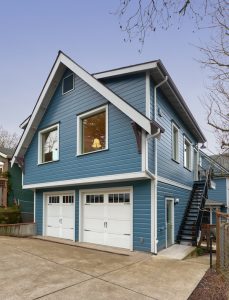
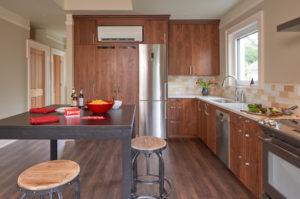
photography courtesy of Robin Rigby Fisher Design/Dale Lang (NW Architectural Photography)
You might call it an experiment. In 2016, a client approached Portland-based Birdsmouth Construction about adding a 665-square-foot apartment over their two-car garage in Southeast Portland. The plan was to convert it into an Accessory Dwelling Unit, but this wouldn’t be a run-of-the-mill remodel. The homeowner hoped to certify the new digs as a Passive House. Typically, “very small buildings don’t do well as good candidates for certified Passive House,” said Birdsmouth designer Ben Valentin. “But we said we’d give it a shot.” While that initial goal did prove to be out of reach, when the project wrapped in early 2018 the team had fashioned a remarkably energy-efficient structure. Triple-pane windows and continuous super-insulation make for supreme airtightness, while a mini-split heat pump and heat recovery ventilator ensure top-notch ventilation and interior comfort. With the addition of a small solar array, the ADU is now certified Net Zero and generating more energy on site than it needs over a year. We call that a win.
An Energy-Efficient Modular Home in Portland
photos courtesy of Skylab Architecture
Like the many 100-year-old bungalows on this Northeast Portland block, this new home also started with a basement foundation. But that’s where the similarities end. On a sunny fall morning in 2012, semi-trucks arrived at the site to offload the rest of the house. They were soon assisted by giant cranes to lift and stack six angular modules into place, while a crowd of onlookers gathered on the sidewalk to observe the progress. “By 4 p.m. the whole house was there, which was a remarkable thing to watch,” said Je Kovel, architect and principal of Skylab Architecture. “ There’s nothing there in the morning, and then a house is there in the evening.” In 2009, the Seattle-based prefab company Method Homes contacted Kovel to design a modular scheme suitable for city infill lots. It was the recession, the building world was in chaos, and Kovel had the bandwidth. “We wanted to be able to provide a custom architectural solution through a more accessible process and hopefully at a more accessible price point,” he said. His firm devised, essentially, a “set of building blocks” composed of 100-square-foot triangular modules, which can be combined and customized in a range of floor plans that respond to a variety of site conditions. “We had seen in the prefab market that there were a lot of standard floor plans that may or may not fit the site really well, so we wanted to move beyond that limitation,” Kovel said. He and Method have since dubbed the system HOMB in a combination of the word “home” and the honeycomb aspect of combining modules, with the Portland installation the prototype.
The triangle shape serves a dual purpose. For starters, it’s the “strongest shape,” making it well-suited to truck transportation or being hoisted in the air by a crane. “ They can’t flex as much. That exing would theoretically pop the grout out of the tile or put cracks in the drywall,” Kovel said. Being able to deliver a building in such a complete state means project timelines can be buttoned up more quickly. The Portland home only took six or seven months from basement excavation to move-in, which is several months less than a normal house build might need. The triangle shape also serves up a dramatic, almost iconic, form. “We liked how they help break up that boxy modern look that’s so common in prefab,” Kovel said. Part of the owners’ brief was for a sustainable home, which the prefab process is well-positioned to deliver. Construction waste is significantly reduced since the home is built off-site in Method’s Ferndale, Washington, factory, where off-cuts and excess can be saved and used on other projects. The controlled conditions eliminate exposure to the elements and potential moisture problems. According to Skylab, the home’s exceptional insulation values and high- performance building skin deliver energy savings of roughly 40 percent over homes built to code. Plus, the rooftop is ready for a solar array. Efficient mechanical systems complete the picture, as well as low-VOC finishes for improved indoor air quality. Said Kovel: “Prefab in general is just a tighter, greener approach to building.”


